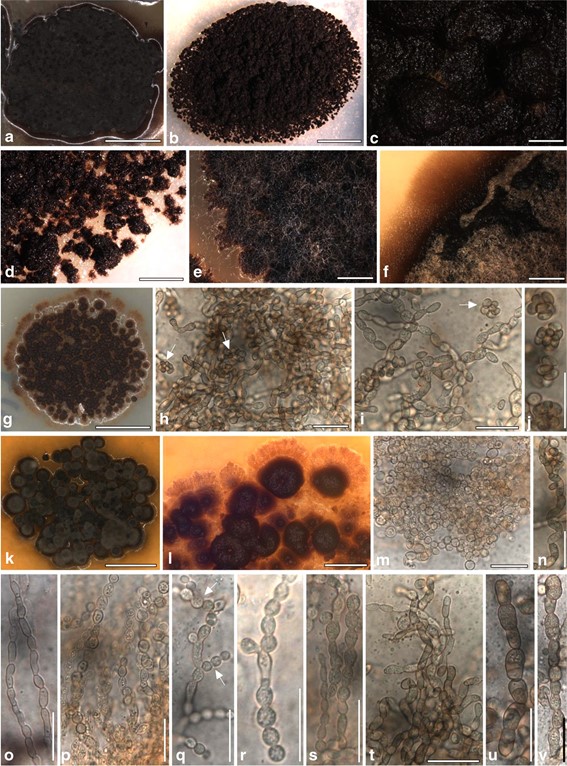Melanina gunde-cimermaniae Grube, Muggia, de Hoog, sp. nov.
MycoBank number: MB 838767; Index Fungorum number: IF 838767; Facesoffungi number: FoF; (Fig. 6)
Etymology. The species is named in honor of the Slovenian mycologist and microbiologist Nina Gunde-Cimerman, who has contributed significantly to the knowledge of stress tolerance of black yeasts.
Holotype: GZU-A1111 (LMCC0452), cultured strain, pre- served in a metabolically inactive state (20 November 2013, date at which they were first identified from culture isolates). Isolated from the thallus of Rhizocarpon geographicum (GZU A697), Austria, Styria, Central Alps, Steirisches Randgebirge, Koralpe, Ochsenofen, ca. 14 km W above Schwanberg, in the vicinity of the summit, on big boulders NW, 46° 46′ 30″ N/15° 00′ 50″ E, 18.VII.2012, L. Muggia and A. Fleischhacker.
Isotype: GZU-A1120.
Diagnosis: Endolichenic (cryptically present in lichen thal- li), asexual fungi. Colonies growing extremely slowly in vitro (reaching 1.5 cm in a year), dark gray to black. Hyphae toruloid, composed of almost isodiametric cells, 4–5 μm wide, hyaline to heavily melanized. Superficial, hyaline hyphae rare; yeast-like growth present in the central internal part of the colony, with slightly verrucose cell walls. Conidia pale pigmented, 3–4 μm wide organized in chains, likely resulting from a blastic-percurrent or arthric ontogeny.
Distribution: Isolated form alpine lichens growing on siliceous-schist rocks scattered in wide, alpine areas of pastures or dwarf shrub formations, between 1800 m and 2100 m a.s.l., and from calcareous rocks in dry Mediterranean habitat (Spain). Isolated from the following lichen species: Lecanora polytropa; Lecidea lapicida; Lecidea sp.; Rhizocarpon geographicum; Tephromela atra; and Umbilicaria cylindrica. Material examined EUROPE, Austria, Koralpe mountain range, on siliceous-schist and gneissic rocks, alt. 1800–2100 m a.s.l., endolichenic fungi isolated from lichen thalli, May–July 2012, Lucia Muggia and Antonia Fleischhacker, strain numbers A513, A525, A526, A529, A538, A543, A566, A581, A864, A872, A880, A898, A919, A933, A929, A934, A957, A958, A1018, A1070, A1072, A1095, A1108, A1111, A1113, A1120, A1137, A1144, A1145, A1169, and A1187.
Notes: Axenically isolated strains are reported in Table S1 and in Muggia et al. (2016, 2017).

Fig. 6 Morphological characters of Melanina gunde-cimermaniae. Strains a, o A934; b, d A872; c A538; e A880; f A919; g–j, n, t A1163; k, q–s A1111 (type); l, m, p A1187; and u, v, A1120. a–g, k, l Colony appearance on solid malt yeast medium after 1 year of growth. h– j, m–s Toruloid hyphal organization and filaments of conidia, likely resulting from a blastic-percurrent ontogeny. h–j, q Clumps of conidia (arrows in H, I, Q). t–v Chain of conidia likely resulting from an arthric ontogeny. Scale bars: a, k 5 mm; b 4 mm; c 0.4 mm; d, e, l 1 mm; f 0.5 mm; m–v 20 цm
